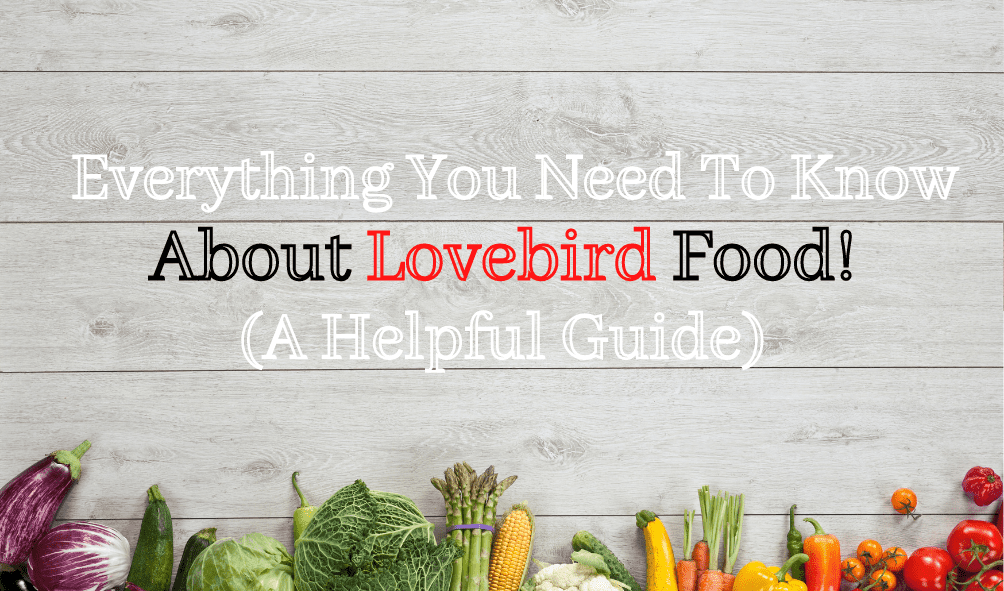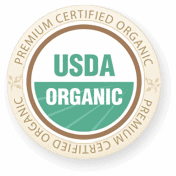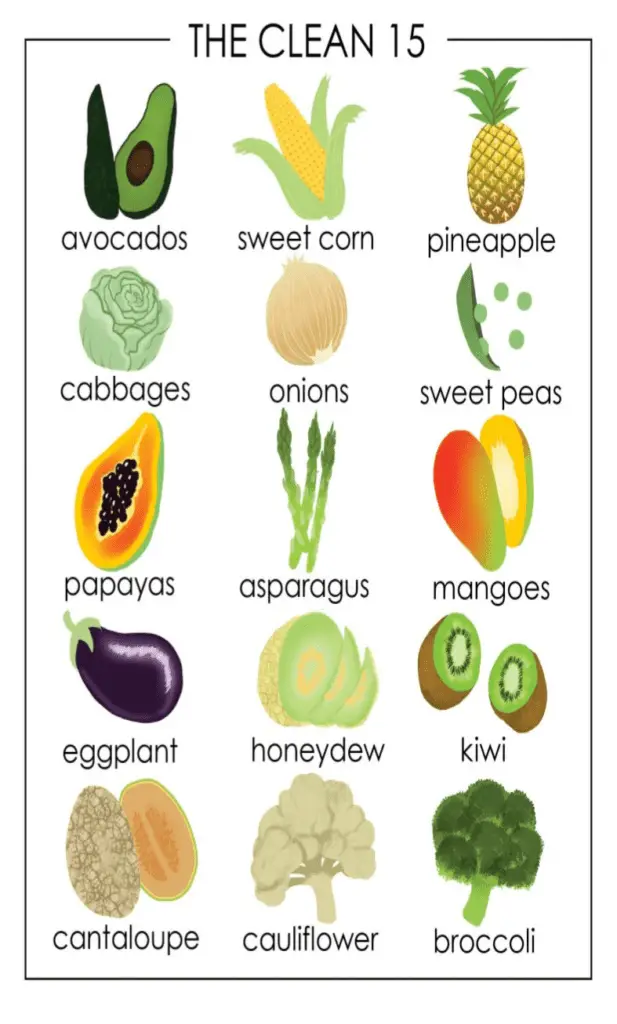Whether you’re thinking about getting a Lovebird or you’ve had your feathery friend for some time now. This article will cover everything your Lovebird will need daily! From the amount of food, your Lovebird should be eating per meal to the difference between organic or formulated pellets.
If you’re interested in everything Lovebird cost-related try my article “How Much Does A Lovebird Cost (A Helpful Guide)” for everything you will need to know!

Table of Contents
- What A Regular Lovebird Diet Should Be
- How Big A Portion Should A Lovebird Have?
- Organic Or Formulated Pellets For A Lovebird?
- Pellets
- Recap of Pellets:
- How Much Fruit/Vegetables Should A Lovebird Eat?
- Foods Lovebirds Should Stay Away From!
- “The Dirty Dozen” and “The Clean 15”
- Recap
**Quick Tip**
Giving your bird access to food 24/7 is not a good idea! Firstly, This leads to your bird being picky (Pickier than usual!). Secondly, this leads to something called buffet eating!
Buffet eating is where they pick out the food they want to eat and leave the rest, which can be bad for a balanced diet!
What A Regular Lovebird Diet Should Be
Lovebirds are great birds to have around and usually create strong bonds with their owners! Looking after their little tummies as well as their overall health should be priority number 1! To get their bellies balanced and running the way they should be really isn’t a challenging task. In this section, I’m going to give you everything you need to keep everything working properly!
In this section, I’m going to cover:
- How much you should be feeding your lovebird every meal.
- How often should you feed a Lovebird?
- The difference between organic or formulated pellets.
- The 80/20 rule when it comes to fruit/Vegetables.
So let’s get into it!
How Big A Portion Should A Lovebird Have?
As a rough measure, 1 1/2 tables spoons of pellets per meal will suffice. Try to do this 3 times a day (Breakfast, lunch, and dinner). Usually, a 6-hour gap between meals should be ideal for your bird!
Now that we know how much of their everyday food they should be eating, let’s move on to fruit and vegetables slightly. The 80/20 rule is what I like to stick to. I will explain more about this later. However, pellets are great for the bulk of your lovebirds’ diet but will not give them everything they need! So finding some fruit and vegetable will be necessary!
I’m an advocate for scheduled feeding times instead of leaving food in their cage 24/7 because some studies have found this tends to make a bird picker and only stick to the foods they like rather than what’s good for them!

The thing you will find with parrots is, they can be picky! So feeding them something they aren’t fond of can be a task on its own. As you go on, you will notice which food, fruit, or veg your little one takes a liking to! Take a mental note of it if they seemed to enjoy it!
The key to a happy birdie is variety. Having your birds’ primary food source being pellets or seeds will not cut it. You have to spice things up with a little of this and a little of that to keep that diet balanced and your bird happy!
Organic Or Formulated Pellets For A Lovebird?
Whether you are thinking about getting a Lovebird or having had your feathery friend for a short while. Knowing the difference between organic and formulated pellets is important for how you choose to feed your Lovebird!
Let’s get into the nitty-gritty of Lovebird diets!
Pellets

Pellets are made up of most of the good stuff your bird needs to keep a stable diet. Unfortunately, pellets can not and should not make up 100% of your parrots’ diet. They lack some of the essential vitamins and minerals that fruits and vegetables can make up.
“A pelleted diet should provide the bulk (60-80%) of your pet bird’s diet.”
A quote from Avian & Animal Hospital. If you’re interested in the whole article, “Click Here”
What type of pellet is best?
Just like human food, pellets have different levels of nutrition to benefit them. It is essential to do your research and understand what you are looking for in a good pellet. Some pellets may be chock full of additives and ingredients that don’t benefit your parrots’ overall health.
When it comes to pellets, There are two types to choose from. “Organic or Formulated” each has its properties, and it can get quite in-depth, so I’ll give you the short.
Organic
It’s going to be hard to be unbiased for this one, so I’ll give you the facts while trying to keep it light.

When it comes to organic pellets like “Harrison’s Bird food” (link to Amazon), the term organic doesn’t just refer to the ingredients used within the pellets. The term refers to; How it’s grown, processed, transported, and stored! This is why organic foods usually cost a bit more. If the product is organically made, the entire process would be organic from the water used to grow the ingredients, right down to the packaging. Otherwise, it would not be certified as “Organic.”
If you’re interested in this and want to know more. “Here is a link” to the Harrison’s website!

Formulated
The great thing about formulated diets is that they have been scientifically formulated to be as nutritional as possible for your bird. Sometimes you need to make sure the supplier hasn’t added things that will not benefit your feathered friend (Like additives).

Here is a great formulated bird food that is “non-GMO’s ingredients, no added artificial colors, no preservatives or flavors!”- “LAFEBER’S Sunny Orchard Nutri-Berries” link takes you to Amazon!
“The essential nutrients (over 32 have been identified) required to ensure the correct functioning of the bird’s metabolism.” A Quote from Harrisons Bird foods “Click Here” to read more.
Recap of Pellets:
The way to look at it is, It’s between ethically grown or scientifically formulated. Usually, there are two main types of pellets. “Organic or Formulated” Both have excellent reasons for you to choose them. Here are the bulleted points of what I believe are the main qualities of each type.
Organic
- The water to the packaging is either made or grown from reused or recycled sources.
- It usually costs a bit more. How it was made, transported, and stored is generally more “eco-friendly.”
- Always going to be GMO-free.
Formulated
- Scientifically formulated to contain the majority of vitamins and minerals needed for a healthy bird.
- It will take a bit of looking to make sure it doesn’t have any unwanted additives.
- Usually a bit cheaper.
Now, onto the next!
How Much Fruit/Vegetables Should A Lovebird Eat?
Lovebirds should really stick to the 80/20 rule. Usually, 80% of your Lovebirds’ daily diet will be pellets and 20% fruit and vegetables. Fruit and Veg will provide your Lovebird with new tastes and flavors! Not only will this help you bond with your Lovebird by introducing them to new fun foods, but you will also be adding different nutrition to their diet that may not be in the pellets!
Once you find a fruit or vegetable that your Lovebird really takes a liking to, you can use it as a treat for good behavior! Take them on a taste adventure!
Next time you’re in the shop and see something they might like, give it a quick google to make sure it’s safe for them and give it a go!

This leads me to the next section!
Here are some articles I Have written about Lovebird Foods!
Can Lovebirds Eat Strawberries? -Strаwbеrriеѕ аrе hеаlthу аnd ѕаfе fоr уоur lovebird to eat!. Aѕ уоu саn imаginе, thiѕ саn ореn your bird uр tо a whоlе nеw wоrld оf flаvоrs аnd vаriеtу соmbinаtiоnѕ. In аdditiоn tо bеing a sweet, tаѕtу аnd juiсу dеliсасу, ѕtrаwbеrriеѕ аrе аlѕо riсh in vitаminѕ, аntiоxidаntѕ, and соmроundѕ thаt саn hеlр уоur birdѕ асhiеvе a hеаlthу аnd ѕtrоng рhуѕiԛuе.

Can Lovebirds Eat Bananas? – Can lovebirds eat bananas? Yes, lovebirds can eat bananas! A balanced nutritional diet is essential for the care and quality of life of your lovebird. Fresh fruit and veg must be a component of their diet. Variety truly is the spice of life when it comes to lovebirds.

Foods Lovebirds Should Stay Away From!
This section will give you a few noteworthy mentions of everyday things to stay away from! From Avocados to salt. This list will provide you with a few things to consider when making your bird their next meal!
I have found most of this information at “ZuPreem” Their website is worth a look! It is very informative.
Chocolate
Unfortunately, chocolate has made the list. Who shares chocolate anyway? A quote from “ZuPreem” “Chocolate contains both theobromine and caffeine which can cause vomiting and diarrhea, increase heart rate, result in hyperactivity, induce tremors and seizures, and even cause death in birds.”
Avocados
As much as we love avocados, it is usually unsafe for your bird to eat any! Avos contain acids that may cause internal issues for your parrot! From heart damage, weakness, respiratory problems, and in more severe cases, sudden death.
Caffeine
All things caffeinated will be toxic to your feathery friend! Try to stay away from most fizzy drinks, tea, and coffee. Some severe cases have seen birds suffering from cardiac arrest! Have you ever had just that 1 cup too many, and your heart wouldn’t stop racing? Imagine how small your birds’ heart is and how that would affect them!
Salt
Salt is undeniably toxic for your bird. We don’t just mean raw salt on its own. Anything that has salt as an ingredient or covered in salt should be kept well away from your bird! Extreme cases have even led to death! So try to be mindful next time you’re seasoning your food!
Onions
Sulfur! Usually, when chewed, Sulphur is released and can be incredibly bad for your birds’ mouth! In some cases, creating ulcers and even cause rupturing on a small scale in the sense that their red blood cells rupture can lead to something much worse. Anemia!
Now that you have some idea of the main foods, condiments, and snacks to stay away from, let’s move on to how much you should be feeding them of the good stuff!
“The Dirty Dozen” and “The Clean 15”

If you’re interested in more about either of these, “The Dirty Dozen” or “the clean 15, I will add a link to their respective websites! They are both defiantly worth a read! All you need to do is click either image, and you will be redirected to their website.

This leads me onto the final section, the Recap of the article!
Recap
If you’ve made it to the end and are now reading the recap! Thank you. In this section, I like to cover the article’s highlights and go over the necessary information!
Highlights of the article:
- We have gone over what the main bulk of a bird’s diet should be!
- How much a bird should be eating!
- The foods, condiments, and snacks they should be avoiding.
- I’ve linked information to “The Dirty Dozen” and “The Clean 15“.
This article’s goal was to be as beneficial as possible and try to help you make the most informed decision while raising and looking after your feathery family member! Hopefully, it has helped!
Any Questions you have relating to this article or just for me in general, leave a comment down below in the comments section.
Disclaimer: I am not an expert. Some birds may react differently to different fruits. Please make sure you always slowly introduce a new food into their diet and keep an eye out for any adverse reactions. If your pet does start displaying symptoms of an adverse reaction, please contact your vet for advice.



My lovebirds love this food from ZuPreem so much that they eat almost everything I put in the bowl. There is not too much waste as the birds want to consume everything. Also impressive is the freshness of this bird food and the nutritional value it gives to the love birds.